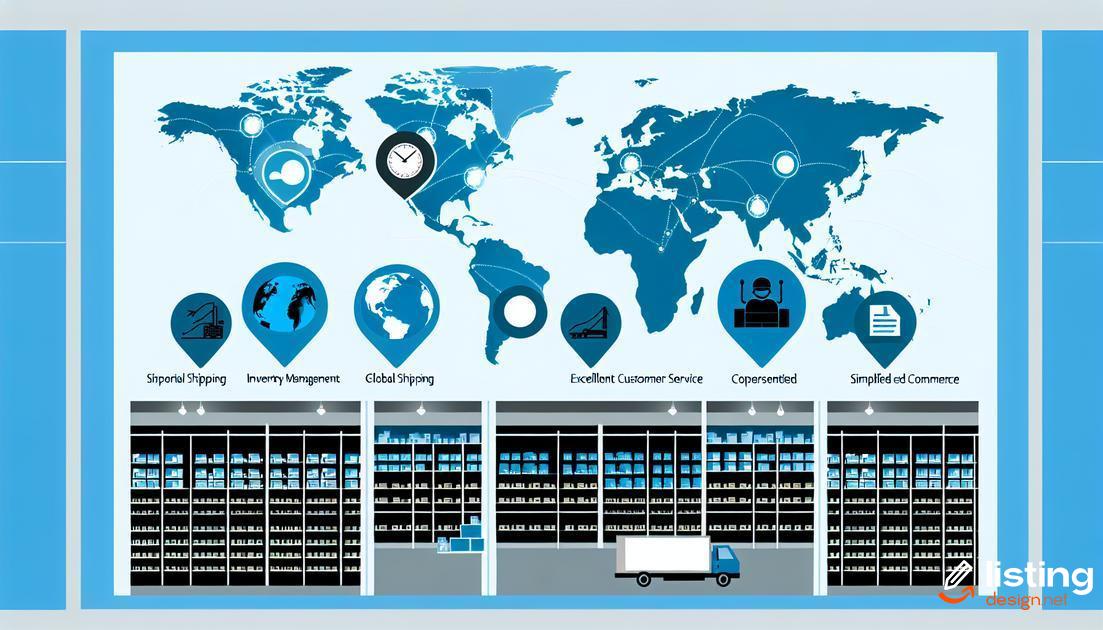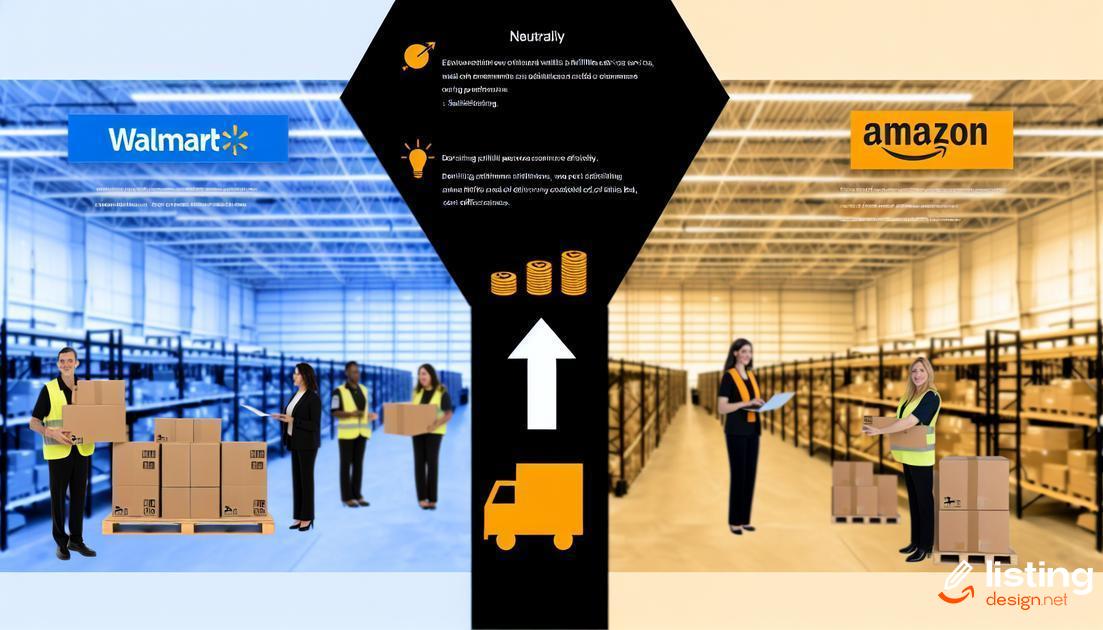Choosing between Walmart Fulfillment Services (WFS) and Amazon FBA can be challenging. Both platforms offer unique benefits for sellers looking to streamline their e-commerce operations. Understanding the specifics of each service is essential to making an informed decision. This article will guide you through the key features, pricing, and overall user experience of both Walmart Fulfillment Services and Amazon FBA, helping you decide which one suits your business needs better.
Table of Contents
Overview of Walmart Fulfillment Services
Walmart Fulfillment Services (WFS) is designed to help sellers store, pack, and ship their products directly to customers. Leveraging Walmart’s extensive logistics network, WFS allows sellers to benefit from fast and reliable shipping. It is an appealing option for those looking to optimize their eCommerce operations.
Sellers who use WFS can store their inventory in Walmart’s fulfillment centers. When an order is placed, Walmart takes care of picking, packing, and shipping the product to the customer. This process helps to ensure timely and accurate deliveries, enhancing the customer experience.
One key advantage is Walmart’s extensive market reach. With a massive customer base, sellers can tap into a larger audience than they might reach on their own. Additionally, products fulfilled by WFS are eligible for Walmart’s TwoDay Delivery program, attracting more buyers who prioritize fast shipping.
WFS also offers various tools and resources to assist sellers in managing their operations. For example, the Seller Center provides insights and analytics to track performance and optimize listings. Sellers can also benefit from seamless integration with Walmart’s marketplace, making it easier to manage both in-store and online sales.
Overview of Amazon FBA

Amazon FBA (Fulfillment by Amazon) offers a unique opportunity for sellers to leverage Amazon’s vast logistics network. By using FBA, sellers can store their products in Amazon’s fulfillment centers, and Amazon takes care of packing, shipping, and customer service. This end-to-end fulfillment solution helps businesses scale quickly without investing in their own logistics infrastructure.
Storage and Fulfillment
Sellers send their inventory to Amazon’s fulfillment centers, where items are stored securely. When an order is placed, Amazon picks, packs, and ships the product directly to the customer. This streamlines the sales process and helps companies focus on other business aspects, such as marketing and product development.
Prime Eligibility
One of the significant advantages of using Amazon FBA is gaining access to millions of Prime members. Products fulfilled through FBA are eligible for Amazon Prime’s two-day shipping, making them more attractive to potential buyers.
Customer Service and Returns
Amazon FBA includes customer service management as part of its offering. Amazon handles all customer inquiries, returns, and refunds on behalf of the seller, ensuring a consistent and reliable customer experience.
Multi-Channel Fulfillment (MCF)
Amazon’s Multi-Channel Fulfillment allows sellers to fulfill orders from other sales channels (such as eBay or their own websites) using Amazon’s fulfillment network. This integration helps maintain consistent delivery experiences across different platforms.
Key Features of Walmart Fulfillment Services
Fast and Reliable Shipping
Walmart Fulfillment Services (WFS) offers fast and reliable shipping options. With its vast network of distribution centers, Walmart can ensure timely deliveries across the United States, enhancing customer satisfaction.
Competitive Pricing
WFS offers competitive fulfillment pricing, which includes storage, picking, packing, and shipping fees. This can be particularly beneficial for smaller businesses looking to manage costs while scaling operations.
Seamless Multichannel Integration
Sellers can leverage Walmart’s robust multichannel integration capabilities. WFS integrates smoothly with various e-commerce platforms, allowing sellers to manage their inventory and orders from a single dashboard.
Enhanced Visibility and Reach
By using WFS, sellers can tap into Walmart’s extensive customer base. This enhanced visibility can drive higher sales and improve brand recognition.
Professional Customer Service
Walmart provides professional customer service support to both sellers and buyers. This includes handling customer inquiries, returns, and refunds, ensuring a seamless customer experience.
Inventory Management Tools
WFS offers advanced inventory management tools, enabling sellers to keep track of their stock levels, monitor sales performance, and plan restocks efficiently.
Secure Storage Facilities
Walmart’s fulfillment centers are equipped with secure storage facilities, ensuring that products remain safe and in optimal condition until they are shipped to the customer.
Comprehensive Reporting and Analytics
Sellers receive detailed reporting and analytics, providing insights into their sales performance, customer behavior, and inventory levels. This data-driven approach helps sellers make informed business decisions.
Flexible Return Policies
WFS supports flexible return policies, making it easier for customers to return products if needed. This flexibility can enhance customer satisfaction and loyalty.
Overall, Walmart Fulfillment Services offers a comprehensive solution for e-commerce sellers, combining competitive pricing, robust integration, and reliable customer service to help businesses grow.
Key Features of Amazon FBA

Amazon FBA (Fulfillment by Amazon) offers several standout features that make it a popular choice for sellers looking to outsource their order fulfillment. Below are some of the key features:
Advanced Storage Solutions:
Amazon FBA provides scalable storage solutions tailored to manage a large volume of products. Sellers can store their merchandise in Amazon’s fulfillment centers, which helps in managing inventory efficiently.
Prime Eligibility:
Items fulfilled by Amazon are eligible for Amazon Prime, ensuring fast and free shipping for Prime members. This can significantly increase product visibility and sales.
Multi-channel Fulfillment:
Amazon FBA isn’t limited to just Amazon marketplace sales. Sellers can use FBA to fulfill orders from other platforms such as eBay, their own websites, and other sales channels.
Customer Service Management:
Amazon takes over the customer service responsibilities for FBA orders. This includes handling inquiries, returns, and refunds, saving sellers significant time and effort.
Global Expansion:
Amazon FBA supports international sales by allowing sellers to store inventory in various fulfillment centers around the world, making it easier to reach a global customer base.
Seamless Integration:
Amazon FBA integrates seamlessly with Amazon Seller Central, providing an intuitive interface for managing listings, monitoring sales, and handling inventory.
Pricing Comparison: Walmart vs. Amazon
Walmart Fulfillment Services (WFS) and Amazon FBA both offer competitive pricing structures that can vary substantially based on various factors, including volume, size, weight, and service levels. Understanding the detailed cost components can help sellers make an informed choice:
Storage Fees: WFS charges monthly storage fees based on cubic feet, typically lower than Amazon’s. FBA has tiered storage fees which can be significantly higher during peak seasons (October-December).
Fulfillment Fees: WFS has a simpler fee structure that includes picking, packing, and shipping, generally offering lower rates for smaller and lighter items. Amazon FBA’s fulfillment fees can be more complex, with variable costs depending on item categories, dimensions, and destination.
Additional Costs: Both services may incur additional fees such as long-term storage fees, unplanned service fees, and removal order fees. However, WFS tends to emphasize more predictable costs, while Amazon FBA’s fee structure can have more variability.
Discounts and Incentives: Amazon often runs promotions for new sellers or high-volume sellers, occasionally offering discounted storage and fulfillment fees. Walmart’s incentives are less frequent but could apply to strategic partnerships or high-volume sellers.
For sellers who prioritize lower storage costs and simpler fee structures, WFS might be a more cost-effective option. Those benefiting from variable fulfillment rates, especially during promotional periods, might find Amazon FBA’s pricing more advantageous.
Shipping and Delivery Speeds

When it comes to shipping and delivery speeds, both Walmart Fulfillment Services (WFS) and Amazon FBA aim to provide quick and reliable shipping options. However, the specifics, such as speed and coverage, can vary significantly between the two services.
Amazon FBA often boasts quicker shipping times due to its extensive network of fulfillment centers. With Amazon Prime, many products are eligible for same-day, one-day, or two-day shipping, offering unparalleled speed and convenience to customers.
In contrast, Walmart Fulfillment Services typically offers standard shipping options, although they are expanding their capabilities. Walmart+ members can enjoy expedited shipping, including two-day and next-day delivery, but the geographical coverage might not be as extensive as Amazon’s.
Both services aim to meet customer expectations by leveraging strategically located warehouses. However, Amazon’s established logistics infrastructure generally provides a competitive edge in terms of delivery speeds. This could play a crucial role for sellers looking to reach customers quickly and reliably.
Customer Service and Support
Both Walmart Fulfillment Services (WFS) and Amazon FBA are known for providing extensive customer service and support for sellers. Each platform has its own set of tools and policies to ensure smooth operations and effective issue resolution.
Walmart Fulfillment Services:
- Dedicated support team available to assist sellers with any issues.
- Comprehensive help center with detailed guides and FAQs.
- Direct contact through email and phone for urgent matters.
Amazon FBA:
- 24/7 seller support through phone, email, and live chat.
- Extensive online resources and community forums.
- Priority support for top sellers and Amazon service partners.
In conclusion, both platforms offer strong customer service and support channels, yet the availability of immediate assistance and the variety of support tools can vary.
Inventory Management: Pros and Cons

When assessing inventory management within Walmart Fulfillment Services (WFS) and Amazon FBA, it is vital to explore the strengths and weaknesses of each system.
Pros of Walmart Fulfillment Services
- Seamless Integration: WFS is designed to integrate smoothly with Walmart’s marketplace, ensuring a cohesive experience.
- Control Over Inventory: Sellers maintain greater control over their inventory, allowing for better customization and adaptability.
- Cost Efficiency: Inventory management fees in WFS are relatively lower compared to Amazon FBA, providing a cost-effective solution.
Cons of Walmart Fulfillment Services
- Limited Warehousing Locations: WFS has fewer fulfillment centers, potentially impacting shipping times.
- Learning Curve: Due to its unique system, sellers might experience a steeper learning curve.
- Less Established: Compared to Amazon FBA, WFS is newer and may lack some refined processes.
Pros of Amazon FBA
- Extensive Network: FBA offers a vast network of warehouses, ensuring quicker delivery times.
- Advanced Technology: Amazon’s cutting-edge technology aids in efficient inventory tracking and management.
- Global Reach: With FBA, sellers can easily tap into international markets.
Cons of Amazon FBA
- Higher Fees: Inventory storage and management fees in FBA tend to be higher, affecting profit margins.
- Rigid Processes: FBA has stringent guidelines, limiting customization.
- Reduced Control: Sellers have less control over their inventory, as Amazon handles most of the logistics.
Ease of Use and Integration
When evaluating fulfillment services, the ease of use and integration capabilities are paramount for smooth business operations. Walmart Fulfillment Services (WFS) offers a user-friendly interface that integrates seamlessly with Walmart’s seller center. It provides straightforward steps for order management and inventory tracking, making it accessible for sellers of all levels. The integration process involves syncing your existing eCommerce platforms and handling bulk uploads efficiently.
On the other hand, Amazon FBA (Fulfillment by Amazon) is known for its robust integration capabilities, supporting multiple eCommerce platforms, including Shopify, WooCommerce, and Magento. The streamlined process allows sellers to connect their inventories easily. The intuitive dashboard of Amazon FBA simplifies order processing, returns, and customer service, ensuring fluid operations and reduced manual effort.
Both WFS and Amazon FBA offer APIs for custom integration, enhancing flexibility and control. However, Amazon FBA’s integration tools are often seen as more versatile and extensive, making it an excellent choice for tech-savvy sellers needing advanced features.
Ultimately, the choice between WFS and Amazon FBA on the grounds of ease of use and integration may come down to individual preferences and specific business requirements. Sellers might prefer Amazon FBA for its comprehensive integration capabilities, whereas Walmart Fulfillment Services stands out for its straightforward, easy-to-navigate interface.
Seller Requirements and Restrictions

Sellers looking to use Walmart Fulfillment Services (WFS) must adhere to specific guidelines. One primary requirement is that sellers need to be part of the Walmart Marketplace. Products must comply with Walmart’s Marketplace Retailer Agreement and meet strict quality standards.
Walmart places several restrictions on what can be sold through WFS, such as prohibiting certain categories like perishable goods, regulated products, and items deemed unsafe. WFS requires sellers to maintain accurate inventory levels and promptly handle any compliance issues that may arise.
Amazon FBA sellers also face a rigorous set of requirements. Sellers must create a Professional Seller account and agree to Amazon’s terms. Specific product restrictions apply, including prohibitions on hazardous materials and certain food items. Amazon emphasizes the importance of high-quality listing content and can deactivate listings that do not meet their standards.
Additionally, both Walmart and Amazon mandate certain performance metrics. Walmart requires sellers to maintain good customer service scores, while Amazon utilizes metrics like Order Defect Rate (ODR) and Late Shipment Rate to ensure a positive customer experience.
Success Stories: Walmart Fulfillment Services
Success Story: Jane’s Home Decor saw a remarkable increase in sales after switching to Walmart Fulfillment Services (WFS). By utilizing WFS, Jane managed to reduce her shipping times significantly, which led to a higher rate of customer satisfaction. Another success story comes from Tech Gadgets Inc., which expanded its market reach by leveraging Walmart’s vast customer base. This resulted in a 30% boost in their quarterly profits.
Moreover, Organic Foods Co. experienced a drastic drop in cart abandonment rates when they started using WFS. The seamless integration with Walmart’s marketplace allowed them to automate their inventory management and focus on scaling their business. In addition, Small Fashion Boutique gained a competitive edge by offering faster delivery services, which contributed to a 25% increase in repeat customers. These companies demonstrate how effectively WFS can drive business growth and ensure customer satisfaction.
Success Stories: Amazon FBA

Amazon FBA has become a game-changer for many sellers. Take, for instance, John, who started his e-commerce business with a modest investment. By leveraging Amazon FBA, John was able to focus on scaling his business while Amazon took care of storage, packing, and shipping. He saw his sales triple within a year.
Another success story involves Sarah, who utilized Amazon’s vast marketplace to reach international customers. By using FBA, she optimized her supply chain and managed to reduce overhead costs, leading to a 40% increase in her profit margins.
Even small businesses can achieve big growth. Consider the case of Mike and Lisa, a couple running a homemade skincare brand. They struggled with logistics until they joined FBA. With Amazon handling fulfillment, their brand exposure increased, and they saw a surge in repeat customers due to Amazon’s reliable shipping services.


